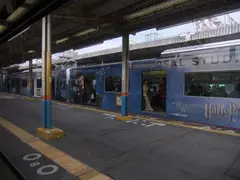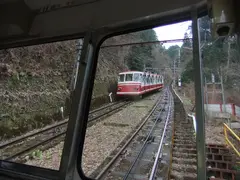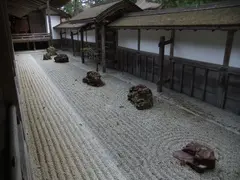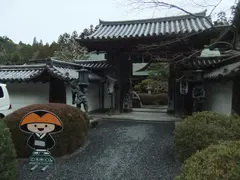 I wasn’t sure when I dropped off my main case that the front desk
staff at the Karasuma understood me (I was very relieved to see my case
when I reached Osaka the following day). The guide was already there
to escort me to Shin Imamiya (new Imamiya) so I didn’t have time to
do emails etc. I was glad of her help as we pushed our way through
the rush hour commuters for a long long journey. I was also glad
to find the guide knew the film “Always Sunset on Third Street”!
Other Japanese I had spoken just looked blank when I mentioned that
film.
I wasn’t sure when I dropped off my main case that the front desk
staff at the Karasuma understood me (I was very relieved to see my case
when I reached Osaka the following day). The guide was already there
to escort me to Shin Imamiya (new Imamiya) so I didn’t have time to
do emails etc. I was glad of her help as we pushed our way through
the rush hour commuters for a long long journey. I was also glad
to find the guide knew the film “Always Sunset on Third Street”!
Other Japanese I had spoken just looked blank when I mentioned that
film.
One train we saw as we took the loop line round Osaka had Harry Potter blazoned all over it. There’s a Universal Studios theme park in Osaka and it was school holidays to intensify the crush. Another train had a cute bear on it named Go Go - a chain of Chinese restaurants named 551 had donated a polar bear cub to Osaka zoo. It’s no longer a cub now. A good chat with the guide, her English wasn’t bad but I had to expand some questions like “How long have you been a guide”.
 Quite a trip still after the guide left me to my fate at Shin Imamiya,
the train went through very scenic hills and then we had a funicular
railway up to Koyasan. I could have done without two fellow tourists
who chatted away loudly. Koyasan is the centre of Shingon Buddhism,
one of the major Buddhist sects in Japan. Its founder Kukai went to China,
needed a similar mountain to the sacred Chinese mountains, so got
the help of a god and goddess in the shape of white and black dogs
who showed him Koyasan. Until the Meiji Restoration Shinto and
Buddhism blurred into each other, and Japanese Buddhism seems to have
a lot of Shinto like features to it.
Quite a trip still after the guide left me to my fate at Shin Imamiya,
the train went through very scenic hills and then we had a funicular
railway up to Koyasan. I could have done without two fellow tourists
who chatted away loudly. Koyasan is the centre of Shingon Buddhism,
one of the major Buddhist sects in Japan. Its founder Kukai went to China,
needed a similar mountain to the sacred Chinese mountains, so got
the help of a god and goddess in the shape of white and black dogs
who showed him Koyasan. Until the Meiji Restoration Shinto and
Buddhism blurred into each other, and Japanese Buddhism seems to have
a lot of Shinto like features to it.
Koyasan opened up to tourists a few years ago, and it was opened up in a modern way. The buses are modern and English speaking visitor friendly. My hotel Fukuchi-In turned out to be a real Buddhist temple with Zen gardens, sliding doors, leave shoes at the entrance and wear red slippers in the corridors (special white slippers in the toilets which I was very relieved to find were the new bidet style electronic toilets!), I slept on the floor on a bedroll placed on top of the tatami mats. Monks (I assume they were monks but some were girls) served me my vegetarian dinner and breakfast in my room. Dinner was superb, the best meal I’ve had for a long time, but I was worried about knocking over the burner for the tofu soup pot. This hotel which must be close to a ryokan also had an onsen but I wasn’t brave enough to try it. And the Fukuchi-In also had very good Wi-Fi!
 I couldn’t check in until 3pm so I went to tour the Koyasan site
as much as I could in a rainy afternoon, after having some Kitsune
udon for lunch. Koyasan has plenty of shops (both normal and
souvenir), banks, normal facilities. The monks drive cars and
use mobile phones.
I couldn’t check in until 3pm so I went to tour the Koyasan site
as much as I could in a rainy afternoon, after having some Kitsune
udon for lunch. Koyasan has plenty of shops (both normal and
souvenir), banks, normal facilities. The monks drive cars and
use mobile phones.
I went round the main temple complex which had a splendid red pagoda (and also torii gates which I thought were Shinto artefacts). Went round one of the temples there which was the administrative heart of Shingon. Explained all about Kukai’s history, and subsequent almost deification. Then I went to Okunoin which is a pretty big graveyard. There were parties of white clad Buddhist faithful being shown round this ‘Mecca’, but graveyards even big graveyards don’t do a lot for me. There was some relief in the oddness of some of the memorials which broke up the monotony of stupas and lanterns. There was a space rocket (go figure), and Nissan had a couple of assembly line workers on a corporate effort. By this stage I was pretty full of temple seeing.
 I got a trainee girl learning English when I finally checked in,
I hope I was encouraging to her. But it was hard going as any
questions threw her off her reading of the script. I read
Patricia McKillip’s “Ombria in Shadow”, a superb book! So a great
day including the splendid meal. I had been expecting to eat
with others but in a way eating alone made it more meditative.
The Fukuchi-In does cater for feeding passing coachloads, they
had a gang of Germans to cope with in the morning.
I got a trainee girl learning English when I finally checked in,
I hope I was encouraging to her. But it was hard going as any
questions threw her off her reading of the script. I read
Patricia McKillip’s “Ombria in Shadow”, a superb book! So a great
day including the splendid meal. I had been expecting to eat
with others but in a way eating alone made it more meditative.
The Fukuchi-In does cater for feeding passing coachloads, they
had a gang of Germans to cope with in the morning.